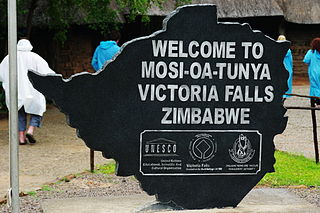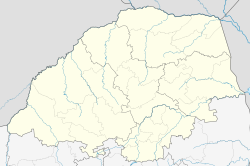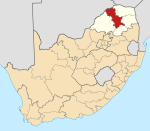
Harare, formerly known as Salisbury, is the capital and largest city of Zimbabwe. The city proper has an area of 982.3 km2 (379.3 sq mi), a population of 1,849,600 as of the 2022 census and an estimated 2,487,209 people in its metropolitan province. The city is situated in north-eastern Zimbabwe in the country's Mashonaland region. Harare is a metropolitan province, which also incorporates the municipalities of Chitungwiza and Epworth. The city sits on a plateau at an elevation of 1,483 metres above sea level, and its climate falls into the subtropical highland category.

isiNdebele, also known as Southern Ndebele is an African language belonging to the Mbo group of Bantu languages, spoken by the Ndebele people of South Africa.

Babol, known as "Orange Blossom City;" also Romanized as Bābol; formerly known as Barfrouch, is a city in the Central District of Babol County, Mazandaran province, Iran, serving as capital of both the county and the district. Babol is divided into two metropolitan areas.

Bulawayo is the second largest city in Zimbabwe, and the largest city in the country's Matabeleland region. The city's population is disputed; the 2022 census listed it at 665,940, while the Bulawayo City Council claimed it to be about 1.2 million. Bulawayo covers an area of 546 square kilometres in the western part of the country, along the Matsheumhlope River. Along with the capital Harare, Bulawayo is one of two cities in Zimbabwe that are also provinces.

Swazi or siSwati is a Bantu language of the Nguni group spoken in Eswatini and South Africa by the Swati people. The number of speakers is estimated to be in the region of 4.7 million including first and second language speakers. The language is taught in Eswatini and some South African schools in Mpumalanga, particularly former KaNgwane areas. Siswati is an official language of Eswatini, and is also one of the twelve official languages of South Africa.

At least thirty-five languages are spoken in South Africa, twelve of which are official languages of South Africa: Ndebele, Pedi, Sotho, South African Sign Language, Swazi, Tsonga, Tswana, Venda, Afrikaans, Xhosa, Zulu and English, which is the primary language used in parliamentary and state discourse, though all official languages are equal in legal status. In addition, South African Sign Language was recognised as the twelfth official language of South Africa by the National Assembly on 3 May 2023. Unofficial languages are protected under the Constitution of South Africa, though few are mentioned by any name.

Mokopane, formerly known as Potgietersrus, is a town in the Limpopo province of South Africa.
The Northern Ndebele people are a Nguni ethnic group native to Southern Africa. Significant populations of native speakers of the Northern Ndebele language (siNdebele) are found in Zimbabwe and in South Africa.

Tsholotsho, originally known as Tjolotjo, is a district in Matabeleland North province in Zimbabwe. Its administrative centre is at Tsholotsho business centre which is located about 98 km north-west of Bulawayo. Districts around Tsholotsho include Lupane, Hwange, Umguza, and Bulilima. The Manzamnyama River separates Tsholotsho from Bulilima District, whilst the Gwayi River separates it from Umguza and Lupane districts, and the Hwange National Park separates it from Hwange District.
Ga-Rankuwa is a large settlement located about 37 km north-west of Pretoria. Provincially it is in Gauteng province, but it used to fall in Bophuthatswana during the apartheid years, and under the North West province until the early 2000s.
Lebowakgomo is the seat of the Lepelle-Nkumpi Local Municipality and was the capital of the former Bantustan of Lebowa. Lebowakgomo lies 45 km (28 mi) southeast of the Limpopo capital of Polokwane. The majority of Lebowakgomo's inhabitants speak SePedi.

Mberengwa, originally known as Belingwe, is a district in Midlands province in Zimbabwe. The district is now divided into sub-districts: Mberengwa North, East, West and South. It is bounded by Gwanda in Mberengwa west, and by Zvishavane in its northern zone, to the south it stretches to Neshuro, Chikombedzi and bounded by Manyuchi dam.

The Tonga people of Zambia and Zimbabwe are a Bantu ethnic group of southern Zambia and neighbouring northern Zimbabwe, and to a lesser extent, in Mozambique. They are related to the Batoka who are part of the Tokaleya people in the same area, but not to the Tonga people of Malawi. In southern Zambia they are patrons of the Kafue Twa. They differ culturally and linguistically from the Tsonga people of South Africa and southern Mozambique.

Many languages are spoken, or historically have been spoken, in Zimbabwe. Since the adoption of its 2013 Constitution, Zimbabwe has 16 official languages, namely Chewa, Chibarwe, English, Kalanga, Koisan, Nambya, Ndau, Ndebele, Shangani, Shona, sign language, Sotho, Tonga, Tswana, Venda, Xhosa. The country's main languages are Shona, spoken by only 42% of the population, and Ndebele, spoken by roughly 39%. English is the country's lingua franca, used in government and business and as the main medium of instruction in schools. English is the first language of most white Zimbabweans, and is the second language of a majority of black Zimbabweans. Historically, a minority of white Zimbabweans spoke Afrikaans, Greek, Italian, Polish, and Portuguese, among other languages, while Gujarati and Hindi could be found amongst the country's Indian population. Deaf Zimbabweans commonly use one of several varieties of Zimbabwean Sign Language, with some using American Sign Language. Zimbabwean language data is based on estimates, as Zimbabwe has never conducted a census that enumerated people by language.
Mosesetjane is a village situated northwest of the town of Mokopane in the Waterberg District of the Limpopo province of South Africa. It is divided into three sections under three chiefs: Chief Kekana of the Kgobudi section, Chief Frans Ledwaba of the Sekgoboko section, and Chief N Lebelo of the Mmalepetleke area.

Berkane Province is located in northeastern Morocco in the Oriental region. It is bounded by the Mediterranean to its north, the Kiss Oued and Oujda Prefecture in the east, Nador Province to the west, and Taourirt Province in the south. The Berkane Province includes under its jurisdiction the towns of Saïdia and Ahfir. The population of the city is 80,012 as of the 2004 census. The population originates primarily from Aït Iznasen, a major tribe which consists of Berber clans. The tribe's descendants are spread widely over the rest of eastern Morocco, usually in cities like Ahfir, Saïdia and Oujda. The eastern dialect of Moroccan Arabic is spoken by most of the citizens, although Berber is still spoken by some of the adults.
Jane Furse is a town in the Sekhukhune District Municipality of the Limpopo province in South Africa, surrounded by the villages of Ga-Moretsele, Madibong, Marulaneng, Mamone, Mokwete and Riverside.
The Bobirwa Subdistrict is a jurisdiction in Botswana. It is populated by the Babirwa (Ba-Birwa) people who came from Transvaal in present-day South Africa.
Temba is a town in City of Tshwane Metropolitan Municipality in the Gauteng province of South Africa.
Ga-Ngwetšana, also known as Ceres, is a large village in Moletši in the Polokwane Local Municipality of the Capricorn District Municipality in the Limpopo province of the Republic of South Africa. It is located about 45 km northwest of the City of Polokwane on the R567 road.














